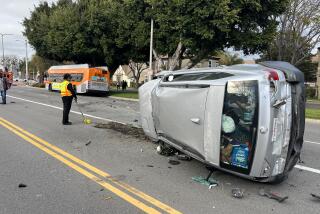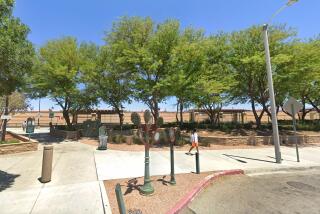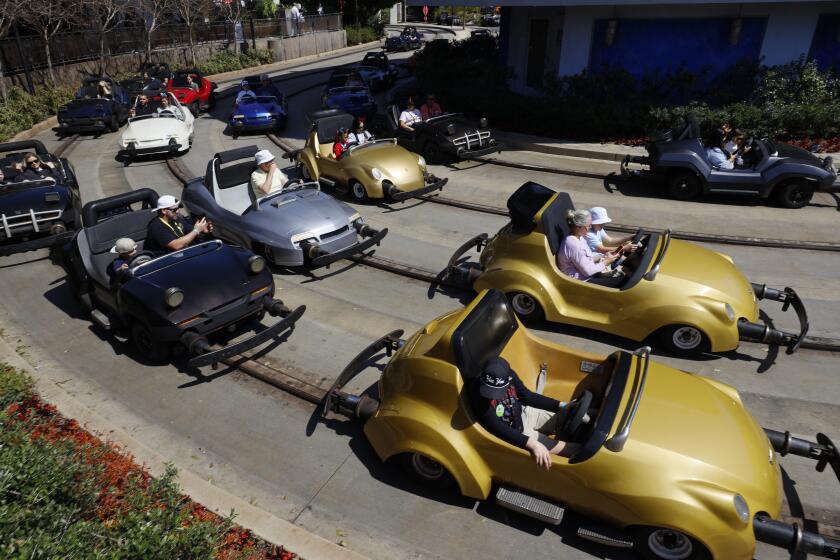6 hurt when Gold Line train hits vehicle
For the second time in 10 days, a motorist was injured in a collision with a Gold Line train after crashing through lowered fiberglass crossing gates along the route between Los Angeles and Pasadena, raising anew the issue of safety along commuter lines running through heavily populated areas.
The crash Friday morning at Avenue 50 and Marmion Way injured six people, including the driver of a Toyota RAV-4 who tried to outrun the train, ignoring flashing signals and ringing bells, authorities said, citing witness reports.
Bystanders pulled the woman from her small SUV before it burst into flames, officials said. The driver, who was not identified, is in stable condition at Huntington Hospital, authorities said.
“We don’t know why she did not stop at the gate,” said V.J. Khawani, director of corporate safety for the Metropolitan Transportation Authority. “Why do people go through red traffic signals and not stop? I really don’t know.”
On Sept. 11, a Gold Line train hit a Ford pickup, injuring seven people including the driver, during morning rush hour at Avenue 55 and Marmion Way in Highland Park, just blocks from the scene of Friday’s crash. Witnesses reported seeing the pickup try to beat the crossing gates at the intersection, said Sheriff’s Lt. Ron Kegel.
The crashes -- the only serious injury accidents on the Gold Line since it opened in July 2003 -- come as the state Public Utilities Commission, which oversees the safety of rail crossings, scrutinizes the proposed light-rail Expo Line.
Concern about the potential for serious accidents along the Expo Line between downtown Los Angeles and Culver City prompted a group of South Los Angeles residents to challenge the MTA’s request for state approval to lay tracks and run trains across major streets. The matter is being heard by an administrative law judge for the commission.
Najmedin Meshkati, a professor with USC’s Viterbi School of Engineering, worked on a two-year study of safety concerns along the Blue Line, which runs from Long Beach to downtown L.A. He said that as the MTA builds the Expo Line, it needs to make a serious effort to inform pedestrians and motorists of the dangers of rail crossings.
“We really need to look beyond one particular incident and do a root cause analysis,” Meshkati said. “This string of accidents at the Gold Line is the best justification for us to take a hard look at what we’re doing . . . and its implications for the Expo Line.”
There have been 792 accidents involving Blue Line trains since the 22-mile route opened in July 1990 -- 632 involving vehicles and 160 with pedestrians. Eighty-seven people have died, mostly pedestrians, and at least 20 deaths were ruled suicides.
In contrast, the Gold Line has had one fatality, ruled a suicide, and the only serious accidents since it opened have occurred in the last two weeks, said Khawani.
“Can it be better? Sure,” said MTA spokesman Marc Littman. “No system’s foolproof.”
The MTA has found that the vast majority of accidents on the Blue and Gold lines were caused by motorists trying to get past lowered crossing gates.
“The challenge we have is you have residents in the region that have become accustomed to bending the rules or violating the rules, creating a higher level of danger risks and a higher propensity for accidents and fatalities,” said Public Utilities Commissioner Timothy Simon. “We have to do a better job of educating the public, and we have to find better ways to educate the public.”
On Sept. 14, nearly 600 people were ticketed at a rail crossing in South Los Angeles as part of an effort by local authorities, Union Pacific railroad and the MTA to warn people about crossing hazards. On Friday, a rail safety education session at Monte Vista Elementary School in Highland Park was called off after the Gold Line accident nearby.
In an effort to deter motorists from driving around gates, the MTA has installed numerous photo-enforcement cameras along the Blue Line and issued thousands of tickets, costing violators at least $271 for the first offense, Khawani said.
Because of the MTA’s troubled safety record on the Blue Line, the Public Utilities Commission forced it to lower the speed of its Gold Line trains traveling through certain neighborhoods, including Highland Park, from a maximum of 50 mph to 20 mph before the 14-mile route opened.
The restrictions were imposed because of concerns about the potential hazard the 44-ton rail cars posed.
The Gold Line opened with what the MTA said were state-of-the-art safety features, including 17 “quad” gates, which are double crossing gates on each side of the tracks. Such gates are harder to go around.
But slower train speeds and better gates can’t deter impatient drivers, officials said. “Even if the train’s going 20 mph, if you hit it, you’re going to lose, whether you’re a car or a truck or SUV or pedestrian,” Littman said, adding that educating is drivers is the key.
Leimert Park resident Damien Goodmon has helped spearhead Expo Communities United, a grass-roots effort that seeks safer design of the rail line. The small group has protested the Expo Line construction authority’s application to the PUC or approval to build tracks across intersections.
He said the group would like the MTA to build its rail above or below street level wherever possible to ensure the safety of motorists and pedestrians.
--
jeffrey.rabin@latimes.com
More to Read
Start your day right
Sign up for Essential California for news, features and recommendations from the L.A. Times and beyond in your inbox six days a week.
You may occasionally receive promotional content from the Los Angeles Times.






